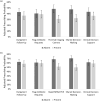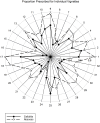Prioritizing emergency department antibiotic stewardship interventions for skin and soft tissue infections using judgment analysis
- PMID: 39829170
- PMCID: PMC11883652
- DOI: 10.1017/ice.2024.211
Prioritizing emergency department antibiotic stewardship interventions for skin and soft tissue infections using judgment analysis
Abstract
Objective: Skin and soft tissue infections (SSTIs) account for over 2.8 million annual emergency department (ED) visits and often result in suboptimal antibiotic therapy. The objective of this study was to evaluate a set of interventions in minimizing inappropriate prescription of antibiotics for presumed SSTIs in the ED.
Design: Case vignette survey.
Participants: A national sample of emergency medicine (EM) physicians.
Methods: Each vignette described a clinical scenario of a presumed SSTI (cellulitis or abscess) and included a unique combination of zero to five interventions (outpatient follow-up, inappropriate antibiotic request flag, thermal imaging for cellulitis or rapid wound MRSA PCR for abscess, patient education/shared decision-making, and clinical decision support). Out of 64 possible vignettes, we asked participants to respond to eight vignettes. Following each vignette, we asked participants if they would prescribe an antibiotic in their everyday practice (yes/no). We built adjusted hierarchical logistic regression models to estimate the probability of prescribing an antibiotic for each intervention and vignette.
Results: Surveys were completed by 113 EM physicians. The thermal imaging, rapid wound MRSA PCR, and patient education/shared decision-making interventions showed the largest decrease (15-20%) in antibiotic prescribing probability. Vignettes with a combination of both a diagnostic intervention (thermal imaging or rapid wound MRSA PCR) and a patient education/shared decision-making intervention had the lowest prescribing probabilities.
Conclusion: We recommend future research focuses on the development and integration of novel diagnostic tools to identify true infection and incorporate shared decision-making to improve diagnosis and management of SSTIs.
Conflict of interest statement
All authors report no conflicts of interest relevant to this article.
Figures





Similar articles
-
Characterizing barriers to antibiotic stewardship for skin and soft-tissue infections in the emergency department using a systems engineering framework.Antimicrob Steward Healthc Epidemiol. 2022 Nov 7;2(1):e180. doi: 10.1017/ash.2022.316. eCollection 2022. Antimicrob Steward Healthc Epidemiol. 2022. PMID: 36386011 Free PMC article.
-
Skin infections and antibiotic stewardship: analysis of emergency department prescribing practices, 2007-2010.West J Emerg Med. 2014 May;15(3):282-9. doi: 10.5811/westjem.2013.8.18040. Epub 2014 Jan 6. West J Emerg Med. 2014. PMID: 24868305 Free PMC article.
-
National trends in ambulatory visits and antibiotic prescribing for skin and soft-tissue infections.Arch Intern Med. 2008 Jul 28;168(14):1585-91. doi: 10.1001/archinte.168.14.1585. Arch Intern Med. 2008. PMID: 18663172
-
Community-associated methicillin-resistant Staphylococcus aureus (CA-MRSA) skin infections.Curr Opin Pediatr. 2010 Jun;22(3):273-7. doi: 10.1097/MOP.0b013e328339421b. Curr Opin Pediatr. 2010. PMID: 20386450 Review.
-
Behavioral Economics and Ambulatory Antibiotic Stewardship: A Narrative Review.Clin Ther. 2021 Oct;43(10):1654-1667. doi: 10.1016/j.clinthera.2021.08.004. Epub 2021 Oct 23. Clin Ther. 2021. PMID: 34702589 Free PMC article. Review.
References
-
- Centers for Disease Control and Prevention (U.S.). Antibiotic Resistance Threats in the United States, 2019. Centers for Disease Control and Prevention (U.S.); 2019. doi: 10.15620/cdc:82532 - DOI
-
- Spellberg B. The antibiotic crisis: can we reverse 65 years of failed stewardship?: Comment on “decreased antibiotic utilization after implementation of a guideline for inpatient cellulitis and cutaneous abscess.” Arch Intern Med 2011;171:1080–1081. doi: 10.1001/archinternmed.2011.26 - DOI - PMC - PubMed
LinkOut - more resources
Full Text Sources
